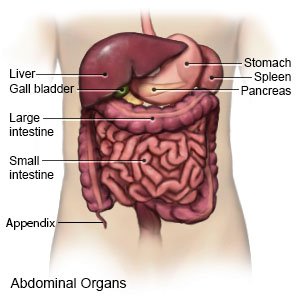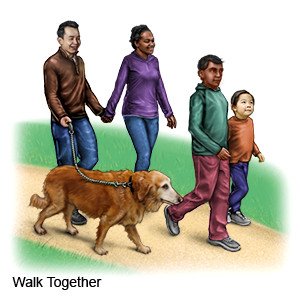Chronic Abdominal Pain in Children
Medically reviewed by Drugs.com. Last updated on Aug 4, 2025.
AMBULATORY CARE:
Chronic abdominal pain
happens at least 3 times in 3 months.
 |
Signs and symptoms
of chronic abdominal pain may come and go. Your child may feel pain in all areas of his or her abdomen or just in 1 area. He or she may not want to eat. He or she may not want to do his or her daily activities, such as school or sports. He or she may also have any of the following:
- Cramping
- Bloating and gas
- Constipation or diarrhea
- Slow growth or growth failure
- Nausea or vomiting
Seek care immediately if:
- Your child's abdominal pain gets worse and spreads to his or her back.
- Your child's bowel movement has blood in it, or looks like black tar.
- Your child cannot stop vomiting, or vomits blood.
- Your child has diarrhea for at least 1 week.
- Your child has trouble breathing, and his or her skin looks pale.
- Your child's pain wakes him or her during the night.
- Your child has trouble swallowing, or pain when he or she swallows.
Call your child's doctor if:
- Your child has pain on his or her right side that does not go away.
- Your child has a fever.
- Your child is not drinking liquids, and he or she is not urinating.
- You have questions or concerns about your child's condition or care.
Treatment for chronic abdominal pain in children
may include any of the following:
- Medicines may be given to help calm your child's stomach and prevent vomiting. Medicines may be given to control your child's anxiety or to lower stomach acid. Medicines may also be given to prevent or treat pain or a bacterial infection.
- Surgery is rarely needed but may be done to treat certain problems.
Manage your child's chronic abdominal pain:
Your child's healthcare provider may give you specific instructions based on your child's age. The following are general guidelines:
- Apply heat on your child's abdomen to help with pain or muscle spasms. You can apply heat with an electric heating pad set on low, a hot water bottle, or a warm compress. Heat should be applied for about 20 to 30 minutes or as long and as often as directed. Always put a cloth between your child's skin and the heat pack to prevent burns.
- Keep track of your child's abdominal pain. This may help your child's healthcare provider learn what is causing the pain. Track when the pain happens, how long it lasts, and how your child describes the pain. Include any other symptoms he or she has with abdominal pain. Also include what your child eats and drinks, and any symptoms that develop after he or she eats.
- Make changes to the foods you give your child, if needed. Do not give foods that cause abdominal pain or other symptoms. Have your child eat small meals more often. The following changes may also help:
- Give more high-fiber foods if your child is constipated. High-fiber foods include fruits, vegetables, whole-grain foods, and legumes such as pinto beans.

- Do not give foods or drinks that cause gas if your child has bloating. Examples include broccoli, cabbage, beans, and carbonated drinks.
- Do not give foods or drinks that contain sorbitol or fructose if your child has diarrhea. Some examples are fruit juices, candy, jelly, and sugar-free gum.
- Do not give high-fat foods. Examples include fried foods, cheeseburgers, hot dogs, and desserts.
- Give more high-fiber foods if your child is constipated. High-fiber foods include fruits, vegetables, whole-grain foods, and legumes such as pinto beans.
- Make changes to the liquids your child drinks, if needed. Do not give liquids that cause pain or make it worse, such as orange juice. The following changes may also help:
- Give your child more liquid, as directed. Give your child liquids throughout the day to help him or her stay hydrated. Ask how much liquid your child should drink each day and which liquids are best for him or her.
- Do not give your child liquid that contains caffeine. Caffeine may make symptoms such as heartburn or nausea worse.
- Help your child manage stress. Stress may cause abdominal pain or make it worse. Your child's healthcare provider may recommend relaxation techniques and deep breathing exercises to help decrease stress. The provider may recommend your child talk to someone about stress or anxiety, such as a counselor or a friend. Help your child get plenty of sleep and physical activity.

Follow up with your child's doctor as directed:
Write down your questions so you remember to ask them during your visits.
© Copyright Merative 2025 Information is for End User's use only and may not be sold, redistributed or otherwise used for commercial purposes.
The above information is an educational aid only. It is not intended as medical advice for individual conditions or treatments. Talk to your doctor, nurse or pharmacist before following any medical regimen to see if it is safe and effective for you.
Learn more about Chronic Abdominal Pain
Treatment options
Care guides
Further information
Always consult your healthcare provider to ensure the information displayed on this page applies to your personal circumstances.
